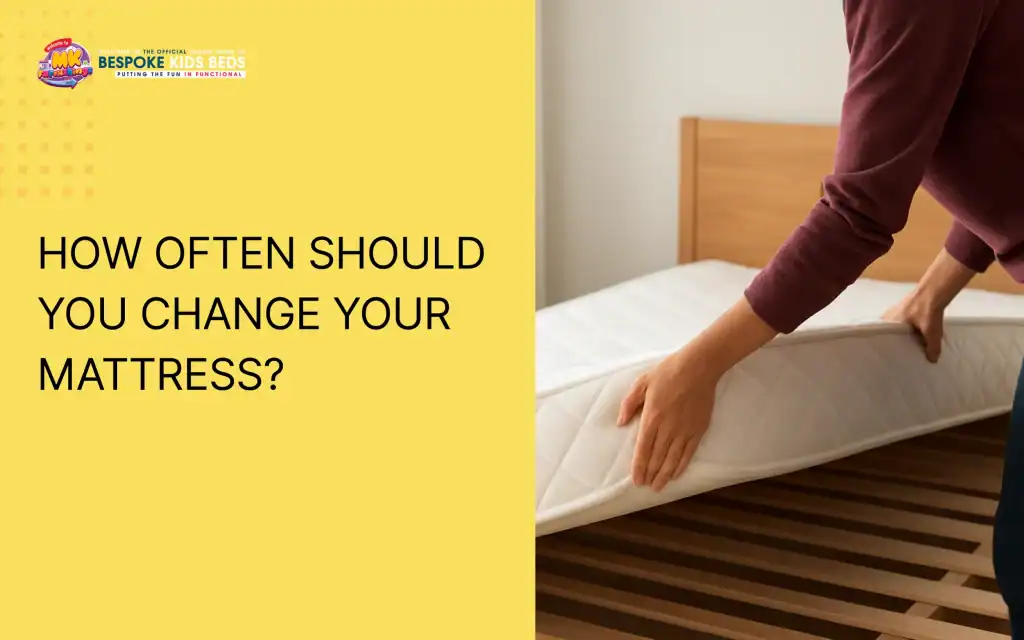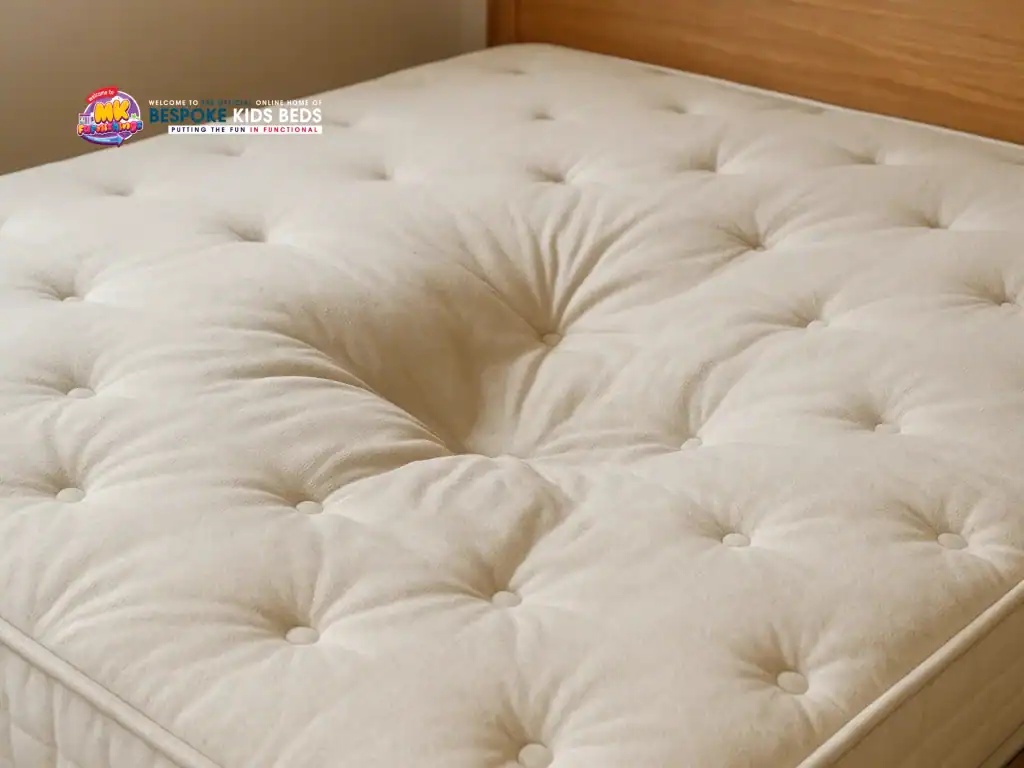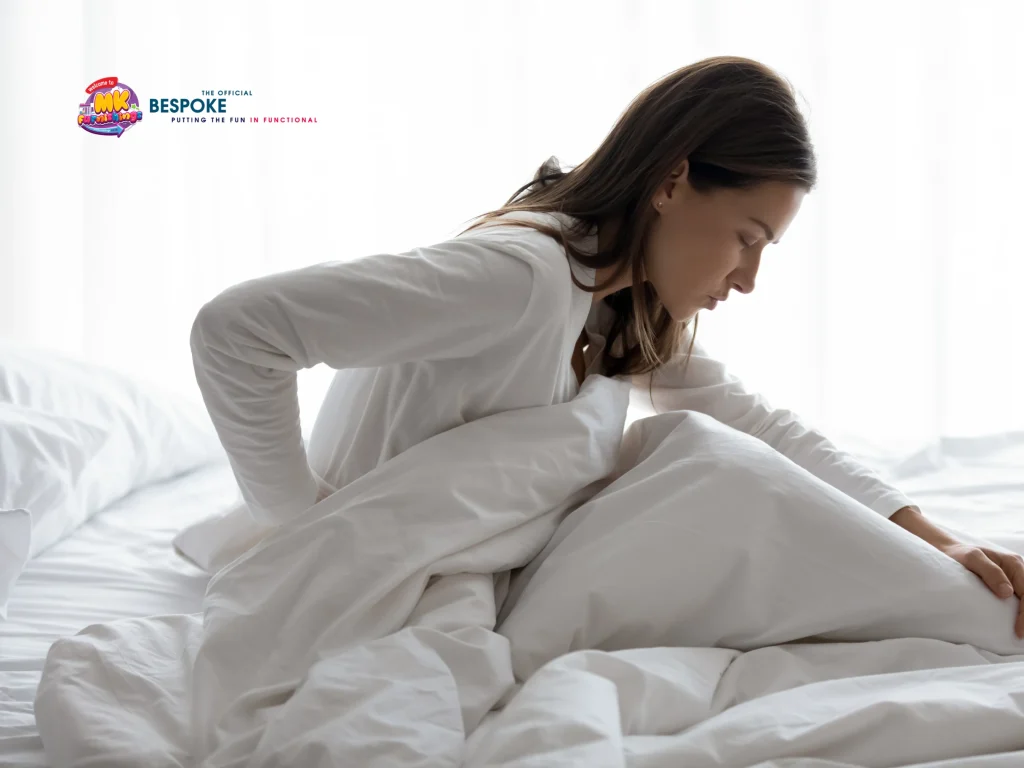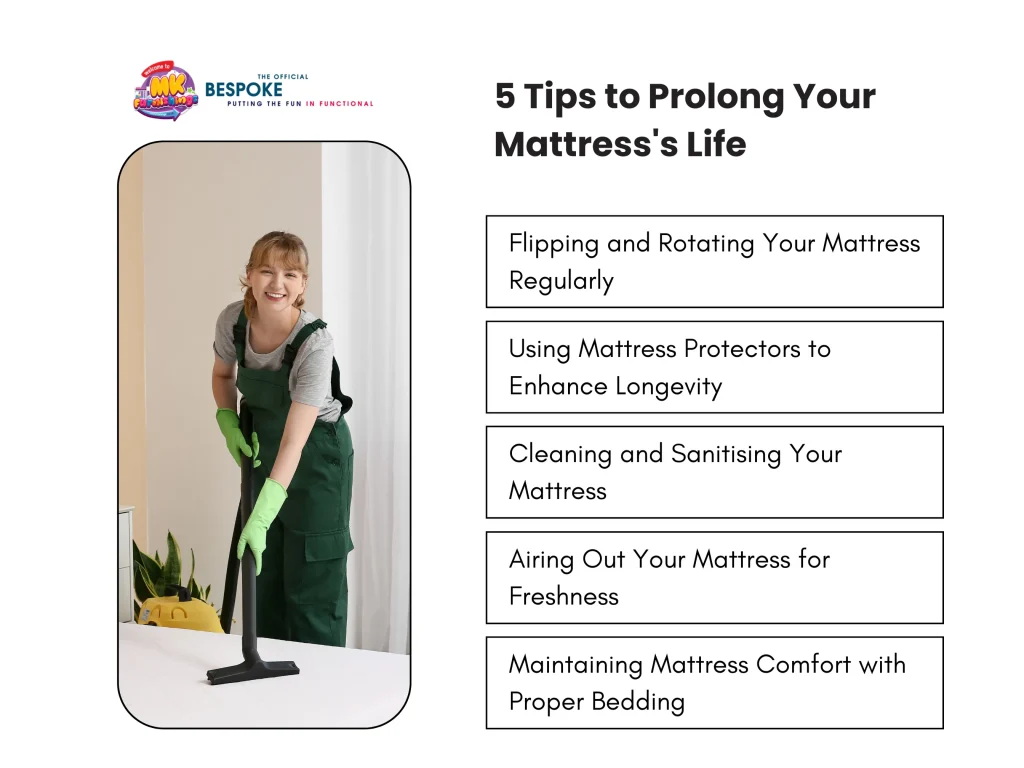
How Often Should You Change Your Mattress?
A mattress should be changed typically anywhere between 6 to 10 years, depending on the mattress type, quality, total usage, and the consistency of the
Enjoy FREE Delivery on All Orders!

A mattress should be changed typically anywhere between 6 to 10 years, depending on the mattress type, quality, total usage, and the consistency of the care routine. Over this time period, mattress materials lose stability through wear and tear, and this gradual change affects the surface that distributes pressure during sleep. Even a well-designed mattress eventually falls victim to this time frame, reaching a stage where support weakens, surface alignment shifts, or hygiene issues appear due to accumulated dust or moisture.
On average, a person sleeps eight hours a day, reaching roughly 236,228 hours of sleep across a lifetime. A mattress handling that level of contact needs to remain steady, clean, and structurally reliable to maintain comfort and protect health. Continuous compression alters firmness and increases dust retention, creating signals that the mattress has reached the end of its effective lifespan. Regular checks of support, surface condition, and hygiene help identify when the mattress no longer meets daily sleep needs.
You know it is time to change a mattress when morning aches develop, the surface shows sagging or lump formation, movement transfer becomes noticeable, or allergy symptoms intensify. A common guideline suggests replacing a mattress every 6 to 10 years, but physical changes in the mattress and disruptions to sleep quality provide the strongest confirmation that the structure has reached the end of its lifespan. The following list outlines the specific warning signs that show a mattress no longer supports healthy and consistent sleep:

Sagging or visible lumps appear when mattress materials weaken and lose their original shape. A sagging mattress leads to a lack of support because the surface no longer distributes pressure evenly. This change affects body posture by creating dips that alter body alignment during sleep. Lumps indicate shifting internal layers that no longer return to a flat position. Any persistent sagging or lump formation signals that the mattress has reached a point where replacement is necessary.

Morning aches indicate that the mattress no longer maintains stable alignment for the spine. Aches from a mattress indicate poor quality support because worn materials compress unevenly, increasing pressure across the neck, back, or hips. This imbalance disrupts rest and forces the sleeper to adjust positions frequently. Examples include stiffness that fades after leaving the bed or discomfort that improves on a different surface. If body aches continue despite routine adjustments, replacing the mattress becomes the appropriate step.

A mattress loses support when its comfort and core layers soften or shift after long-term use. An old mattress loses spinal support by allowing the body to sink more deeply than intended, which disrupts correct body alignment. This decline reduces weight distribution accuracy and may contribute to interrupted rest. Indicators include a sinking sensation in the middle or reduced lift under the lower back. When the mattress can no longer maintain a stable, balanced surface, replacement is necessary for better sleep and health.

An old mattress harbours allergens, worsening health issues because dust buildup, skin cells, and moisture collect within older materials. These conditions may lead to sneezing, congestion, or breathing difficulty, especially during the night. Symptoms that intensify when lying down or improve outside the bedroom often point to mattress hygiene decline. If there are any breathing issues or allergy flare-ups occur more frequently around the mattress, replacing it helps create a cleaner and more comfortable sleep environment.

A mattress becomes uncomfortable when lumps or uneven padding disrupt the surface that should remain flat and supportive. A lumpy mattress causes discomfort during sleep because irregular areas create pressure points that interfere with rest. This unevenness leads to frequent repositioning and reduces sleep consistency. Signs include raised sections, shifting padding, or a textured feel beneath the sheets. When discomfort persists despite rotation or basic care, the comfort layer is no longer functional, and mattress replacement is required.

Unpleasant odours from a mattress indicate moisture retention or the buildup of organic debris within the layers. An old mattress causes bad odours when sweat, spills, or humidity remain trapped, allowing bacteria or mould to develop. Odours that return shortly after cleaning show that internal materials no longer ventilate effectively. If the mattress continues to produce persistent odours even after cleaning or airing out, the internal structure has deteriorated, making replacement the appropriate next step.
A mattress typically lasts 6 to 10 years, though some can last 7 to 12 years or more, depending on factors such as material type, construction quality, usage, and care. The mattress material plays a key role in its lifespan, as different structures respond uniquely to compression and daily pressure. This is why the longevity of a memory foam mattress can differ significantly from a hybrid mattress, because each material reacts differently to weight and movement. Other factors, such as how often the mattress is used and the sleepers’ body weight, also impact its durability, as repeated compression gradually alters the surface over time.
Here are additional factors affecting mattress lifespan:

To prolong your mattress’s life, flip or rotate it regularly, use a mattress protector, keep the surface clean, and air out the mattress to reduce moisture. Proper bedding further supports comfort by preventing unnecessary strain on the materials. These practices distribute pressure evenly within the mattress, limit dust buildup, and maintain a healthier sleep surface. A consistent care routine helps the mattress stay supportive for a longer period and reduces early signs of wear.
Flipping a mattress prevents uneven wear by redistributing pressure across the entire surface. Rotation achieves a similar effect by shifting weight exposure between different sections of the mattress. For best results, follow the manufacturer’s guidance; in many cases, flipping or rotating every 3 to 6 months supports a stable structure. Double-sided designs allow flipping, while single-sided ones rely on rotation. Timely rotation reduces dip formation in frequent sleep zones and helps preserve firmness. Establishing a clear schedule maintains predictable support and contributes to consistent nightly rest.
Mattress protectors prevent dust, spills, and allergens from entering the internal layers. Waterproof protectors shield the mattress from moisture, while hypoallergenic types reduce exposure to dust mites or skin cells. This barrier lowers surface wear and keeps the mattress cleaner for longer periods. Most protectors are easy to wash, simplifying upkeep. Protectors also support regular rotation by keeping both sides of the surface in a stable condition. Choosing a durable, well-fitted protector strengthens long-term mattress performance and helps maintain a cleaner sleep environment.
Keeping the mattress clean removes dust and bacteria collected on the surface and within the upper layers. Vacuuming helps lift loose particles, and approved mattress sprays reduce odours and surface bacteria. Spot cleaning prevents stains from settling into the material and affecting comfort. These methods maintain a hygienic surface and help mattresses typically perform more consistently over time. A cleaning routine every few months preserves freshness and lowers allergen buildup. Regular maintenance strengthens comfort and supports long-term structural reliability.
Airing out a mattress lowers moisture buildup by allowing trapped humidity to evaporate. Excess moisture may encourage mold or bacterial growth when ventilation is limited. Placing the mattress in a well-ventilated space or near circulating air helps remove stale smells and refresh the material. Dry conditions support better performance across different mattress materials. Airing the surface at intervals reduces the need for intensive cleaning and supports a healthier sleep environment. This routine delays structural decline linked to retained moisture.
Proper bedding supports mattress care by reducing friction, easing heat buildup, and preserving surface quality. Breathable sheets stabilise temperature and help maintain comfort during rest. Lightweight bedding and suitable pillowcases encourage airflow rather than trapping warmth. Choosing bedding that matches mattress or bed type like single or bunk bed strengthens comfort and reduces unnecessary strain across the surface. Seasonal changes often affect bedding needs, so selecting adaptable fabrics improves the sleep environment. Using durable, breathable materials supports long-term comfort and contributes to reliable daily rest quality.
An ageing mattress can pose serious health and hygiene risks that affect sleep quality, respiratory function, and skin health. Over time, materials inside the mattress trap dead skin cells, moisture, dust, and bodily oils, creating an ideal environment for dust mites, bacteria, and mold. These hidden accumulations may not be immediately visible but can lead to chronic discomfort and potential health issues. Understanding these risks can help determine when a mattress is no longer safe or hygienic to use.
Old mattresses are a hotspot for dust mites, which feed on shed human skin cells that accumulate over time. As the internal layers become warmer and more humid with prolonged use, dust mite populations thrive. For individuals with asthma or allergies, this can result in increased symptoms such as sneezing, nasal congestion, itchy eyes, and difficulty breathing, particularly noticeable at night or upon waking. The longer a mattress is used without proper protection or cleaning, the higher the concentration of allergens, which compromises indoor air quality and respiratory comfort.
Mattresses naturally absorb sweat, humidity, and occasional spills. Over years of use, this trapped moisture, especially in environments with poor ventilation, can lead to the growth of mould and bacteria within the mattress core. These microorganisms emit musty odours and can trigger or worsen respiratory irritation, persistent coughing, or skin sensitivity. In more severe cases, mould exposure may exacerbate pre-existing respiratory conditions or lead to chronic allergic reactions. Unlike surface-level dirt, internal microbial growth often goes unnoticed until symptoms emerge.
Prolonged use of a mattress without thorough cleaning allows sweat, oils, dead skin, and dust to settle into the upper layers. This debris can clog pores and create irritation points that aggravate sensitive skin. Individuals may experience flare-ups of conditions like eczema, acne, or general itchiness after exposure to contaminated sleeping surfaces. Even regular bedding changes are not always sufficient to prevent skin contact with embedded allergens and bacteria deep within the mattress structure.
Poor hygiene affects sleep quality when dust, moisture, or allergens gather inside an ageing mattress. This buildup may create discomfort, musty odours, or irritated breathing, which disrupts rest and reduces sleep consistency. Frequent waking or difficulty settling often reflects a decline in mattress cleanliness. Protecting the surface with a cover, cleaning it regularly, and rotating the mattress help maintain better hygiene. These practices support uninterrupted rest and indicate when the mattress has reached a point where replacement is necessary.
Memory foam and regular spring mattresses represent two common mattress types, each built with different materials and support structures. Memory foam uses pressure-responsive foam layers that contour to the body, while spring mattresses rely on metal coils for support. These design differences influence comfort, motion control, and long-term durability. Memory foam mattresses typically last around 7 to 10 years, while spring mattresses often span 5 to 10 years under similar care. Choosing between the memory foam and regular mattress depends on preferred comfort, firmness, support needs, and usage expectations.
| Feature | Memory Foam Mattress | Spring (Regular) Mattress |
| Construction | Foam layers that contour to body shape | Metal coils with comfort padding |
| Support Feel | Consistent surface support with reduced motion transfer | Bouncier surface with higher motion transfer |
| Pressure Response | Adapts to body weight and shape for even pressure distribution | Support varies based on coil gauge and coil count |
| Durability | Lasts longer than spring mattresses (7-10 years) | Coils may weaken over time, leading to earlier sagging (may last 5-10 years) |
| Maintenance | Requires rotation for balanced compression | Requires rotation; flipping depends on double-sided design |
| Noise Level | Quiet due to foam construction | Coils may produce noise with age |
| Suitability | Suitable for sleepers wanting contouring support | Suitable for sleepers preferring a firmer, bouncier feel |
Recognising the right time to change a mattress becomes clearer when lifespan, usage patterns, and visible signs of wear are evaluated together. While most mattresses last between 6 to 10 years, signs like sagging, discomfort, poor support, or increased allergy symptoms often indicate it is time for a change. An old or worn-out mattress can contribute to breathing issues, disrupted sleep, and morning stiffness, all of which affect long-term well-being.
Regular maintenance, such as rotating the mattress, using protectors, and keeping it clean, can delay wear but will not prevent inevitable decline. Watching for changes in firmness, hygiene, and comfort helps you recognise when your mattress is no longer meeting your needs. Replacing it at the right time ensures better spinal alignment, deeper rest, and improved overall health.
It is recommended to buy a new mattress anywhere between 5-10 years; however overall factor depends on the material, usage, and visible signs of wear. Other factors, such as visible sagging, discomfort, or hygiene issues, may signal the right time to upgrade sooner. Choosing based on type, usage patterns, and how the mattress feels will guide you when it is time for a new purchase.
A well-maintained mattress can last between 7 to 10 years or longer, depending on its type and how often it is used. Innerspring mattresses, especially with heavy daily use, may show signs of wear after just 5 to 7 years. Rotating the mattress regularly, using a protective cover, and maintaining cleanliness can help extend its lifespan and preserve comfort.
A memory foam mattress typically lasts between 7 to 10 years, depending on the quality of the foam, density, and care. Unlike spring mattresses, memory foam does not rely on metal coils, which makes it less prone to mechanical breakdown. To get the most out of your memory foam mattress, rotate it occasionally, use a mattress protector, and clean it routinely. These practices help maintain support and comfort over time.
You can dispose of a mattress by arranging a bulky waste collection through your local council, taking it to a household waste recycling centre, or donating it to a charity if the mattress is still in good condition. Selling it online is another option when the mattress meets hygiene and safety standards. Some retailers also offer to remove the old mattress when delivering a new one, making disposal more convenient.
Kyle Kane
Owner
Kyle Kane is Co-Owner of MK Furnishings, a family-run business based in UK that specializes in high-quality custom kids’ bunk beds, including triple, double, single, and themed designs. Since launching the company in 2016 alongside his brother-in-law, Kyle has helped deliver and assemble thousands of beds across the UK, Ireland, and beyond. Focused on customer satisfaction, Kyle leads a hardworking team that handles every step from ordering to delivery ensuring a smooth and professional service. His commitment to quality craftsmanship and reliable support has earned MK Furnishings a strong reputation and growing customer base throughout the region.

A mattress should be changed typically anywhere between 6 to 10 years, depending on the mattress type, quality, total usage, and the consistency of the

A bunk bed is dismantled by taking out the bedding and mattresses, removing guardrails, detaching the ladder, separating the top bunk, and unfastening the frame.
Fancy £50 off all orders! Enter in 50off to redeem in the coupon code section